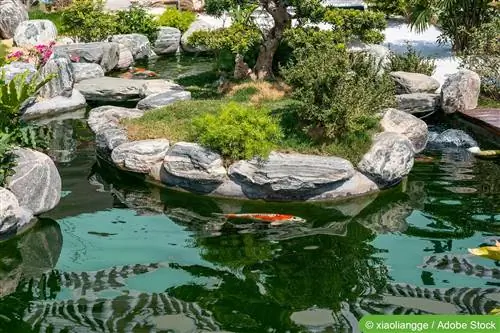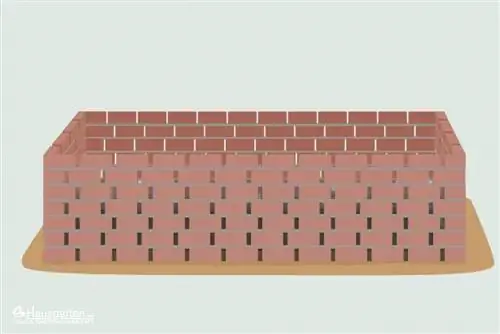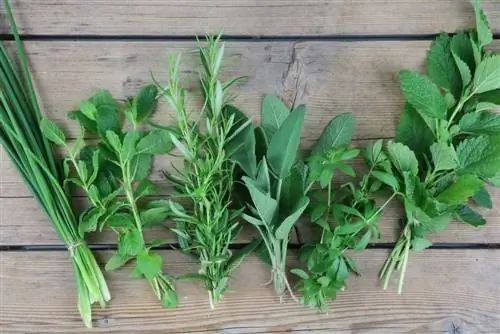- Author admin [email protected].
- Public 2023-12-17 03:39.
- Last modified 2025-01-24 12:45.
There are many different options for garden design and integrating a plant island into your own garden is currently the trend for many hobby gardeners. Plant islands are a visual highlight, regardless of whether they are simply placed in the lawn or add the right touch to the garden pond. It's not that difficult to create your own plant island in the garden. However, its size must fit the garden and neither dominate it nor be barely visible.
The design is tailored to the taste of the hobby gardener and can be easily implemented with little financial resources. First, an interested hobby gardener should look for a suitable place for a plant island. After all, it should be clearly visible and it must also fit into the existing style or provide a contrast. In order to create a plant island within a lawn or as a type of bed replacement, it should be separated accordingly. Natural stones are extremely suitable for this. They are as pretty to look at as they also form an almost indestructible barrier. They also fit almost any garden style.
Designing a plant island in the garden pond
Designing a garden pond is as time-consuming as it is expensive. Nevertheless, a garden pond is one of the most beautiful design elements available to a hobby gardener. Many hobby gardeners put water lilies in their lake as an eye-catcher. A garden pond with a plant island looks even more perfect. With a little skill, you can make it yourself and plant it according to your own taste. Although you can buy pre-formed plant islands at any hardware store, experienced hobby gardeners can just as easily make them themselves, which represents a considerable cost saving. The basis of a plant island is a thick Styrofoam plate, which should have an edge one centimeter high. This means the plants cannot be washed down so easily. The size of the Styrofoam plate should be adapted to the size of the pond. In order to weigh down the plant island and achieve a better position in the water, a few holes are drilled into the Styrofoam to fill them with pebbles. Stable planters can be placed on the gravel, which the hobby gardener fills with potting soil. Gardeners place their plants in these containers, taking natural conditions such as partial shade or full sun into account when selecting the plants. When choosing, it is advisable to choose uncomplicated plants with a varied display of flowers. After planting, the plant island can float on the lake.
Design a plant island as a bed replacement
Plant islands can create beautiful accents in a garden and are therefore enjoying growing popularity among many hobby gardeners. Especially since you can create them yourself at relatively low cost and offer an excellent place for plants that are worth seeing. After a suitable place has been found, the ground must be prepared. If there was already a flower bed in the spot, it is easier to create it. If the plant island is integrated into the lawn, the turf on the site of the plant island should first be carefully removed. A drainage layer made of gravel or lime chippings prevents the formation of waterlogging, which many plants cannot tolerate well. A fleece over the gravel prevents the drainage from mixing with garden soil and also prevents weeds from growing.
Natural stones in different colors are ideal for enclosing the plant island, as long as they match the garden style. However, other limitation options can also be selected. If you want a special eye-catcher as a garden island, you should pile up the topsoil very high, so that almost a hill is created, which is then filled with plants with different growth heights.
Planting for plant island in the pond
- Pennigkraut
- Swamp Forget-me-not
- Watercress
- Juggler's Flower
- Iris
- Narrow-leaved bubbles
- Sedge
- Beaked sedge
- Swamp marigold
- Blood Loosestrife
Plants for planting island as a bed replacement
- Roses
- Dahlias
- Oxtongue
- Tagetes
- Steppe Sage
- Girl's Eye
- Turkish poppy
- Phlox
- Autumn Anemones
- Silver Candles
- Chinagrass
- Pennisetum grass
- Catnip
Caring for a plant island in the pond
The plants on a plant island are actually quite easy to care for if the Styrofoam plate is designed accordingly. After heavy rain, the topsoil may be washed out and should be replaced if necessary. Fertilization is not necessary and watering is unnecessary. However, it requires some work in the fall, as it should be dismantled as soon as the garden pond is winterized. The annual plant residues can be disposed of in the compost, while perennial plants can overwinter in the cellar, for example. The plant island must be cleaned of all plant residues and soil. It must be kept dry so that it is ready in the spring.
Caring for the garden plant island
The care of a plant island in the garden usually depends on the type of planting and the soil conditions. Since heavily flowering plants use a lot of water, hobby gardeners should water and possibly fertilize as necessary in the summer. Hobby gardeners have to remove the bloomed plant remains and regularly monitor for pest infestations such as slugs or voles. Annual plants should be disposed of in the fall. The perennials and bulbous plants can be protected from hard frost, for example, by laying out fir branches. A thick layer of bark mulch serves the same purpose and ensures less weed infestation next year. Rock garden plants, which require very little care and form a beautiful contrast, are also a variant for stocking.
Conclusion of the editors
Plant islands are very popular with modern hobby gardeners, and it doesn't matter whether they float in the garden pond or are created as a replacement bed in the lawn. They are always an attractive eye-catcher in every season. One advantage of plant islands is that they can be created quite inexpensively. When setting up, every hobby gardener can save a lot of costs through their own initiative and cuttings from neighbors or acquaintances can also reduce costs when planting. Because they are generally easy to care for, plant islands are more fun than work. They form a design element for the garden that can be designed very individually and particularly eye-catching.
What you should know about planting islands in brief
To create a plant island, simply look for a nice spot in the garden and fence it in using various stones. To get a natural look, you can choose natural stones. These offer the advantage that they can be easily integrated into almost any garden. The slightly different appearance of the individual stones and the different colors that you can choose here create a harmonious picture with the other garden utensils. You can then plant any type of plant in the middle of the plant island. So you'll definitely be able to enjoy the new flowering plants soon.
But even those who own a pond can brighten it up with a plant island. Instead of putting water lilies in the pond, you can also add a plant island. You can easily build such an island in the pond yourself:
- The basis is a sheet of Styrodur, which should of course be correspondingly strong.
- This should also have a border of at least 1 cm high to prevent the plants from being washed off.
- It's best to drill a few holes in it and then fill them with gravel.
- This will prevent the gravel from being washed into the pond every time it rains.
- It is also important to place sturdy planters on the gravel, i.e. in the holes.
- These are then just filled with soil and the plants can be planted.
- When setting up the planters, you should ensure there is enough space between them.
- Because this is the only way to achieve an aesthetically pleasing result and even larger plants do not interfere with each other.
- You already have a wonderful plant island in the middle of your garden pond that will certainly be second to none. By building the plant island yourself, you also know that you are the proud owner of a truly unique item.






